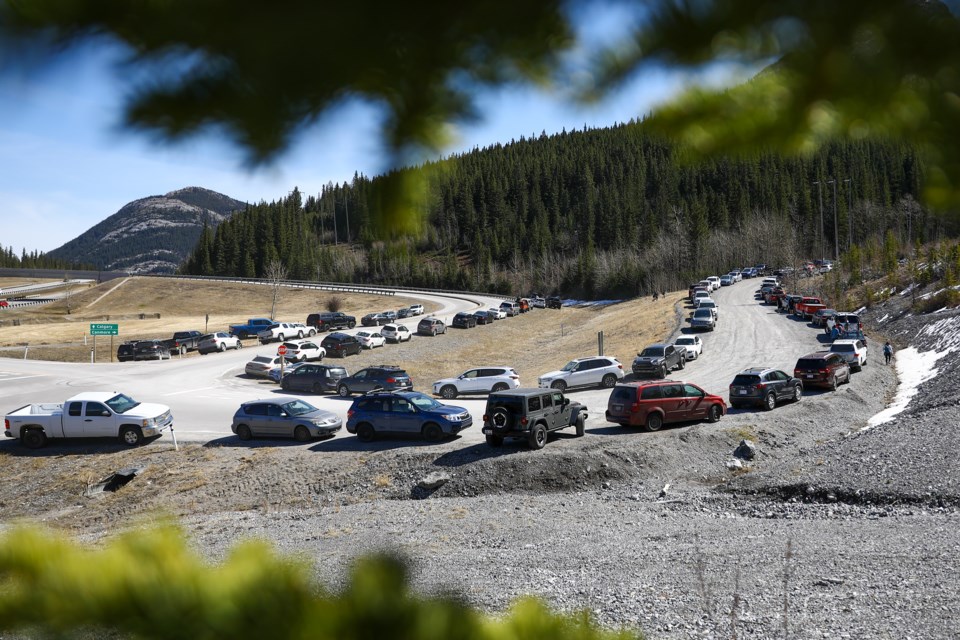KANANASKIS COUNTRY – A public transit pilot extending from the Trans-Canada Highway to the Galatea Creek to Lillian Lakes Trailhead on Highway 40 may be coming to Kananaskis Country as soon as summer 2023.
In a Sept. 27 council meeting, Kananaskis Improvement District (KID) councillors voted unanimously in support of administration outlining options for a three-year public transit pilot to be included in upcoming 2023 budget discussions.
Coun. Darren Enns, who brought the motion forward, said high visitation in the park is leading to increased traffic congestion, particularly along the Highway 40 corridor.
“As a councillor representing Albertans-at-large, my perception is that Albertans are connecting and reconnecting with the beauty of Canada in a significant way,” said Enns. “However, increased visitation comes with increased challenges.”
In 2020, K-Country had a record 5.39 million estimated visitors, which led to capacity issues at trailhead parking lots and other popular destinations. The park sees about four to five million visitors annually, as per Alberta Environment and Parks vehicle counts and calculations.
“In some cases, traffic and parking queues exceed the length of the hike people are trying to access in the first place,” said Enns. “One only has to look on social media to find evidence of the situation that’s occurring daily in Kananaskis throughout the summer.”
Enns said he believes exploring public transit options further is the answer to alleviating traffic and parking pressures in certain areas. The move also aligns with KID’s 2022-27 Strategic Plan, which prioritizes exploring public transit plans, opportunities and partnerships in the region.
Coun. Claude Faerden said a public transit service would go a long way in connecting K-Country to neighbouring communities like Canmore, Cochrane and Stoney Nakoda First Nation.
“Broadly, I’m on board with looking further into what transit looks like in Kananaskis with a future goal of hopefully connecting us to bigger communities," he said, adding the ideal service would benefit both visitors and workers to the area.
“With rising gas prices, we’re regularly going to be challenged with people unwilling to commute when the costs to do so goes up.”
Coun. Darren Robinson said while he likes the concept of the project, public transit that connects commuters to their “final destination” would be better for users.
“My biggest reservation with this is thinking past the junction of Highway 40 and Highway 1,” he said. “Part of that solution of getting people where they need to be is getting them to those other communities.”
Enns looked to Southland Transportation’s On-It service as one example that could fill that gap, citing the success of the service’s spring and summer routes between Banff and Calgary.
“The On-It system between Banff and Calgary which started as a summer pilot running Saturdays and Sundays evolved into a Friday, Saturday, Sunday [schedule] and now runs at fairly full steam all summer,” he said.
“In a perfect world, that would be the connection you would make ... get on a bus in Calgary and stop at the Highway 40 junction to make a choice to come into Kananaskis.”
In the Bow Valley, the towns of Canmore and Banff have prioritized the use of public transit in addressing affordability concerns and easing vehicle congestion. Banff brought in fare free transit for residents this past year and will explore expanding the free services to all people when 2023 service review begins.
Since having Roam transit launch in Canmore in 2017, the service has been fare free for all riders. Canmore council approved growth in weekday and Sunday service at its 2022 budget as ridership numbers have started to surpass the pre-COVID-19 numbers in 2019.
Roam transit also has regular routes to popular Lake Louise and seasonal routes to Lake Minnewanka, Johnson Lake and Johnston Canyon.
A new three-year pilot seasonal route will begin in 2024 that will connect parts of Canmore to the Canmore Nordic Centre and Grassi Lakes in Kananaskis Country after the Town and Roam received $944,000 in funding from the provincial government. The hourly service will utilize 12 existing stops and create 18 new ones, while construction is ongoing this year to improve infrastructure at Grassi Lakes.
Parks Canada also runs shuttles from Lake Louise Ski Resort to both Lake Louise and Moraine Lake in an effort to curb vehicle congestion. The recently released management plans for Banff, Kootenay and Yoho national parks prioritize increasing the use of public transit, further developing it to reach more areas and exploring its use in other areas.
How the service in K-Country would be funded and exactly what it might look like will be considerations of administration when compiling a report, but Enns said any plan is likely to need government investment to succeed.
“I’m a firm believer that we cannot do it all as KID,” he said. “We simply can’t; we don’t have the resources right now and we’re not seeing the benefits of the Kananaskis Conservation Pass trickle-down to us economically.
“At some point, we’re gonna have to find a structure that the provincial government can help support us in a sustainable way. I just think we need to start somewhere, and I want to see a report that says ‘Here’s what it looks like and here’s what it could cost.’”
The Local Journalism Initiative is funded by the Government of Canada. The position covers Îyârhe (Stoney) Nakoda First Nation and Kananaskis Country.




